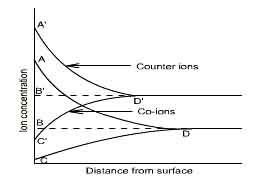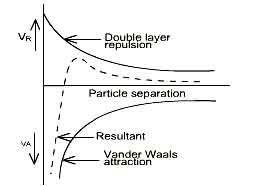General Properties of Colloids
Coagulation and Flocculation
Electrical Double Layer
Destabilization of Colloidal Dispersion
General Properties of Colloids
-
Colloidal particles are so small that their surface area in relation to mass is very large.
-
Electrical properties: All colloidal particles are electrically charged. If electrodes from a D.C. source are placed in a colloidal dispersion, the particles migrate towards the pole of opposite charge.
-
Colloidal particles are in constant motion because of bombardment by molecules of dispersion medium. This motion is called Brownian motion (named after Robert Brown who first noticed it).
-
Tyndall effect: Colloidal particles have dimensioThese are reversible upon heating. e.g. organics in water.
-
Adsorption: Colloids have high surface area and hence have a lot of active surface for adsorption to occur. The stability of colloids is mainly due to preferential adsorption of ions. There are two types of colloids:
-
Lyophobic colloids: that are solvent hating. These are irreversible upon heating. e.g. inorganic colloids, metal halides.
-
Lyophilic colloids: that are solvent loving. These are reversible upon heating. e.g. organics in water.
Coagulation and Flocculation
-
Colloidal particles are difficult to separate from water because they do not settle by gravity and are so small that they pass through the pores of filtration media.
-
To be removed, the individual colloids must aggregate and grow in size.
- The aggregation of colloidal particles can be considered as involving two separate and distinct steps:
-
Particle transport to effect interparticle collision.
-
Particle destabilization to permit attachment when contact occurs.
Transport step is known as flocculation whereas coagulation is the overall process involving destabilization and transport.
Electrical Double Layer
Although individual hydrophobic colloids have an electrical charge, a colloidal dispersion does not have a net electrical charge. The diffuse layer in a colloidal dispersion contains a quantity of counter ions sufficient to balance the electrical charge on the particle. The charge distribution in the diffuse layer of a negatively charged colloid can be represented by the curve ABCD in the figure. The ions involved in this electroneutrality are arranged in such a way as to constitute what is called electrical double layer.

Net repulsion force, which may be considered as energy barrier must be overcome before aggregation occurs. The magnitude of energy barrier depends on (1) charge on the particle, and (2) ionic composition of water.
 
Destabilization of Colloidal Dispersion
Particle destabilization can be achieved by four mechanisms:
|



